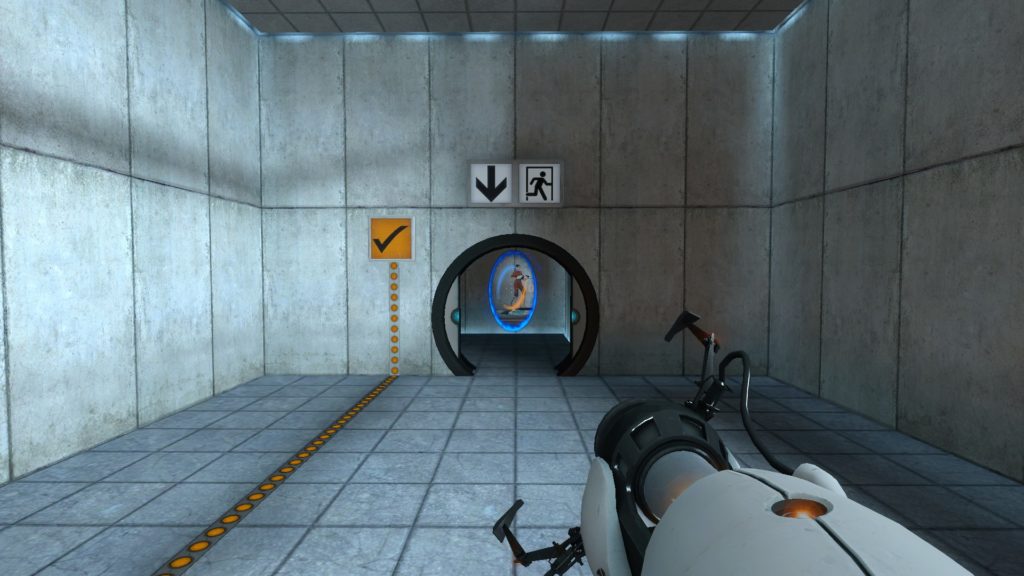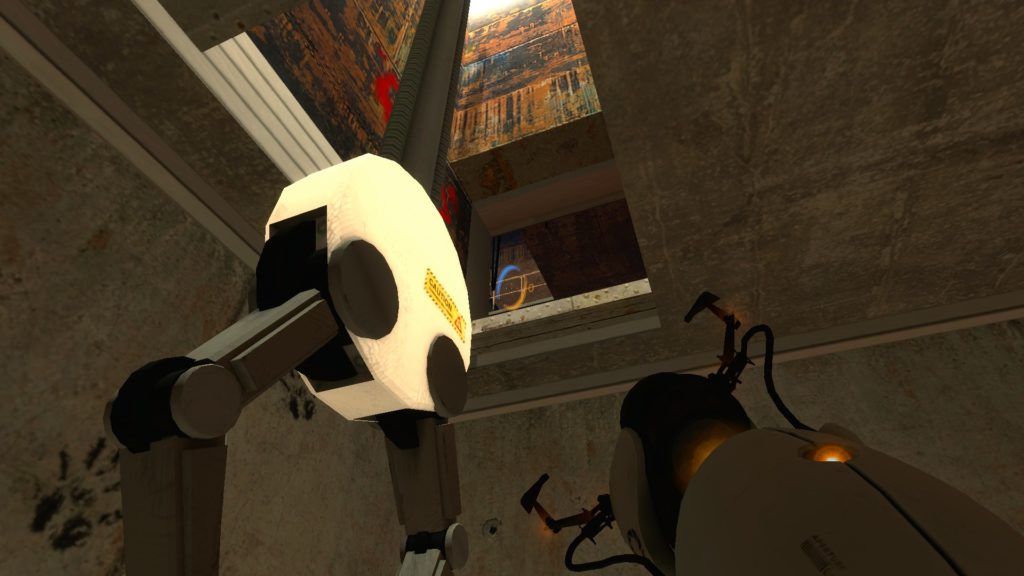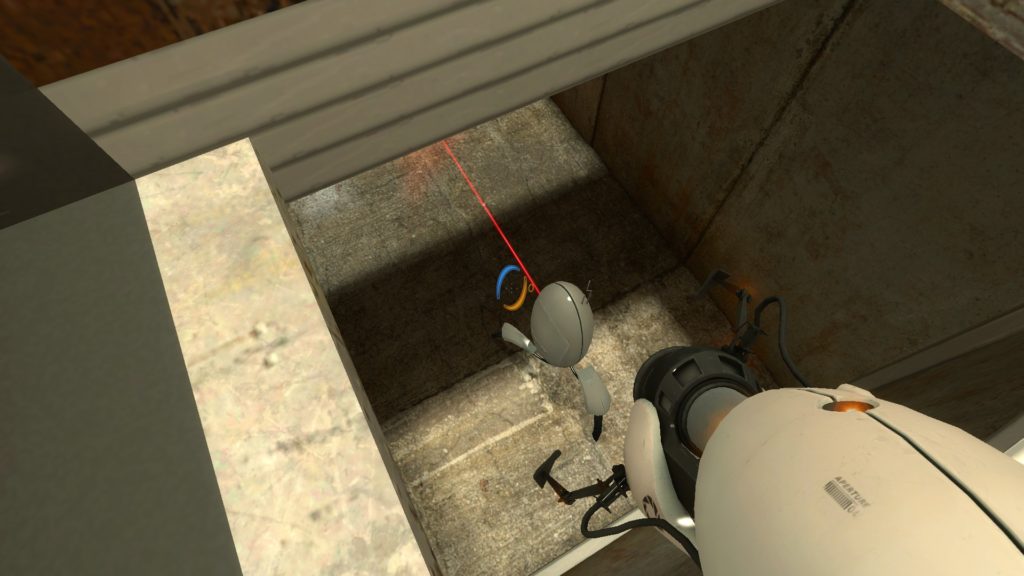This post concludes a series on the way Portal introduces, interweaves, and expands upon its core mechanics to create interesting and engaging puzzles that teach the player every step of the way. If you missed any of the first five parts, read them here, here, here, here, and here before continuing.
Last time, we learned GLaDOS’ true intentions and covered the final five test chambers, which included Chamber 18’s synthesis of nearly everything seen prior. What remains is our escape from the testing track and our journey to the end. While we’ve left behind the deliberate, white, sterile test environment, the back halls of Aperture do not drop the subtle guiding hand which has been with us all the while.
In fact, the escape begins with near-blatant guidance on where to go next; the ledge is in a U-shaped alcove with walls on every side except the one facing the fire. These walls are stark and largely featureless, so with no possibility of forward progress, the player is forced to look in the one open direction and find a second ledge above the hall they came from.

The white light contrasted with the dark terrain and orange fire to offer more subtle guidance—and even outside the test environment, portalability is indicated with the same contrast between dark and light panelling.
The new ledge has similarly few options, but a small corridor to the left leads further onward to something bizarrely normal: a perfectly ordinary door with a handle. The player has never encountered such a door in Portal, but can open it intuitively with the same button as any other non-portal-gun interaction.

The section immediately to follow acts as a gentle reminder that, while the environment looks different, the player is still playing Portal; the stairs up to the next balcony break before they can climb them completely and the following door is behind a grate, both of which require portals to pass.
This entire first segment of the escape aims to get the player oriented to portal mechanics in a setting they aren’t used to. Rather than having a contained setting, they must use the skills they’ve learned to traverse a more open area.

As before, lighting plays a role in guiding them through the area, and the scrawled drawings on the walls invoke the guiding signs found in the test chambers prior. Encouraged camera angles are utilized as well. While giving the player complete control of the camera for a first-person game presents an obstacle, relatively enclosed corridors—and, in this case, clearly indicated portal locations—frame upcoming space in ways that new players are likely to see.
The back rooms lead the player to a pneumatic tube with a hole in it, and jumping inside leads them to the cube dropper in a familiar area: Test Chamber 09, which they worked through before collecting the upgraded Portal Gun. Their new abilities trivialize the once-challenging puzzle; even without a cube, they can simply stand on the button and portal past the door.

The elevator is notably absent, leaving the player to drop down the shaft and continue through the underbelly of the lab. The next room introduces pistons, which act both as platforms and as hazards. To proceed, they must use a pair of pistons to portal to the top of a platform, then carefully cross another piston when it extends to the next ledge.
Traversing this area leads to the next distinct section of the escape—broken up by loading screens in lieu of a nice, convenient elevator—which revolves around the newly-introduced pistons. The first hall leads to a room with five pistons rising to varying heights. These serve to draw the player’s eyes upwards to their next objective, and to see the impact marks from the two pistons which rise all the way to the ceiling.

Only these two pistons are dangerous, and the risk is visibly indicated so the player doesn’t need to try it themselves to find out. They must ride one of the pistons to place a portal in the next hall, but the central piston serves the purpose without fear of death. However, the room to follow forces them to embrace the risk, as the only way to proceed is by riding a piston into a portal on the ceiling, right in the middle of the piston’s impact mark.

A quick portal fling leads the player to a couple of hallways blocked by pistons, which they must portal past to reach the next room. This room is tall, with several layers of horizontal pistons criss-crossing on the way up.

A hastily scrawled arrow informs the player that their objective lies in the same direction, leaving them to portal their way to the top. Notably, many of the actions described here have been quite vague because the openness gives way for a multitude of options. While the same basic steps are generally required to proceed, the details of each player’s solution may vary based on their mastery of the mechanics and their initial approach to the obstacles.
After the player reaches the top of the room, they’re led to a pneumatic tube which acts as a bridge over to a second tube, which is in turn suspended above a pit of acid. Walking along the tube leads them to a large piston with a portalable surface over its impact point. This is evidently the next step forward, but the only portalable surface in reach is suspended above acid—calling back to similar setpieces in Test Chambers 18 and 19.

The defining aspect of this instance is the movement of the piston; not only must the player risk a jump toward the acid, but they must time it effectively to land on the extended piston. Walking along the piston leads them into the third portion of the escape.
The player now finds theirself in a dimly lit hallway with an open door across a wider room. One step inside said room, however, reveals the floor to be several pairs of pistons, which move away and drop the player into an inescapable room.

One by one, doors open in the walls, revealing the return of turrets. These are more difficult to approach than those previously seen, as they are nestled inside alcoves which cover their blind spots. However, their staggered entry offers enough time for a quick-thinking player to take them out one by one, and the room is full of barrels which the player can pick up and use to block their fire.

The ambush may come as a surprise, but there are ample options to deal with it—and the third turret’s alcove hides the way onward.
Specifically, the way onward lies within the ceiling of the alcove, which highlights a recurring trend with the escape: onward often means upward.

While there have been some exceptions, the majority of the ways forward have relied on ascending obstacles in the player’s path. This is in part because high places often act as landmarks. Most rooms are framed such that the player enters them from a low hallway, instantly making their vaulted ceilings noteworthy by their contrast. Artificial light often shines down from them—though this is not to say that lower objectives cannot also be illuminated. Higher landmarks, however, are often visible from a wider range of locations compared to lower ones, which are easily blocked by other footholds.
Travelling through the next room leads the player into another alcove occupied by a turret—which has no chance to retaliate, as they drop in from the back of the alcove rather than the front.

The front panel swings open as they exit, and it stays open at a slight slant. This setup hearkens back to structures within the test chambers used for momentum, continuing yet another trend of the escape challenges: providing the player with examples of what mechanically familiar setpieces look like outside the sterile, test chamber environment.

The tests may have been deliberately constructed for portal movements, but those skills remain applicable even outside of narratively-contrived spaces.
After the return of the turrets earlier in this escape portion, it is perhaps not unsurprising to see the introduction of an entirely new kind of obstacle: rocket turrets. The player passes through the first emancipation grill in a long while into a room with a single pedestal button in front of a pane of glass. When they press it, an orb-shaped turret comes to life, slowly moving its blue laser sight to target the player. It announces a locked target both audibly with a series of beeps and visually when its eye color changes from green to yellow. After locking on target, its eye turns red and it fires a fast-moving rocket which shatters the pane of glass separating it from the player.

They are no longer safe, and they know exactly what kind of damage the new foe can do. There’s no way to defeat or disable it, but there is a door past a pane of glass across the room, and they now have a way to remove it from their path if they take a little risk.
Escaping the rocket turret leads them to yet another pane of glass—in case it isn’t clear, rocket turrets are important. If they didn’t already leave a portal there, they have to backtrack to place one in the turret’s view, then use another to make the rocket break the glass. The final test of understanding comes in the form of yet another pneumatic tube: made of glass and juxtaposed against broken glass, connecting the dots is up to the player.

Breaking the tube causes a cube to fall out which, in a callback to the Companion Cube, can be used as a step up to a nearby vent. Crawling through the vent allows the player to place a portal and move onward, which brings them to the fourth and final section of the escape.
The fourth segment begins with the player making their way through a sewer-like area, which leads them into another room. After wallowing through muck for just a little longer, they can portal up into the room proper—and directly into GLaDOS’ last line of defense. Alcoves open all across the walls, and the familiar laser sights of turrets create a web of danger which will kill an unprepared player.

However, other turret encounters throughout the escape have prepared the player to take care of them. In the pursuit of player agency, they’re not required to take out all of the turrets, but it will be far easier to proceed with them out of the way. In a final test of their quick portal placement proficiency, the player must gain some height to place a portal on a sloped panel, fling from it, and use the extra height to place another portal on a higher sloped panel. They can then shoot a portal on the ground to direct their momentum into an extended jump, but as long as a portal remains on the higher panel, they can simply land and start from the ground instead. A second, far less threatening ambush of two turrets is the final obstacle to GLaDOS herself.

The confrontation with GLaDOS begins by bringing back the incinerator seen previously in Chamber 17, finally providing justification for its memorable introduction. A single core drops from her chassis during her monologue, which the player must drop into the incinerator using a combination of portals and a button across the room.

Notably, the button is in a small hut with two windows: one looking directly across to the incinerator, one looking at GLaDOS—the two most important parts of the chamber. This interaction completely devoid of danger provides the template for the rest of the fight; dropping the first core in the incinerator causes her to begin pumping neurotoxin into the chamber, giving the battle a hard time limit. The rocket turret also returns, once again justifying its abundantly clear crash course just a short while ago.
To make progress in the fight, the player must manipulate the turret to shoot GLaDOS and dislodge another core. The core will move off to a different area of the room, where the player must retrieve them before once again dropping them into the incinerator. As they throw more cores in the fire, GLaDOS becomes more agitated and unstable, making her harder to hit. However, the rocket turret’s sight helps to make sure every shot counts.

Even if the player has trouble figuring out what to do, the room offers them very few options, and the introduction of the rocket turret only a few rooms prior keeps it on their mind for the battle.
After incinerating a total of four cores and enduring incessant mocking from GLaDOS, the game reaches our journey is at its end. The chart is quite complex now, but there are a few common trends.
Whenever a mechanic is redefined or introduced, especially for basic mechanics early on, there are very few other mechanics present. The chart does not effectively convey relative density—that is, to what extent each mechanic appears when it does—but in most cases, the newly introduced mechanic is also given much greater focus while everything else takes a back seat. The basics, such as movement and even the Portal Gun itself, fade into the background; the player becomes used to them, and they become the base on which the more specialized mechanics are built.
I hope you’ve enjoyed this in-depth analysis on Portal’s complex, mechanical symphony. This concludes the series on Portal, but there will be more content coming this way soon. Keep an eye out and I’ll see you next time!


Solid ending to an interesting series